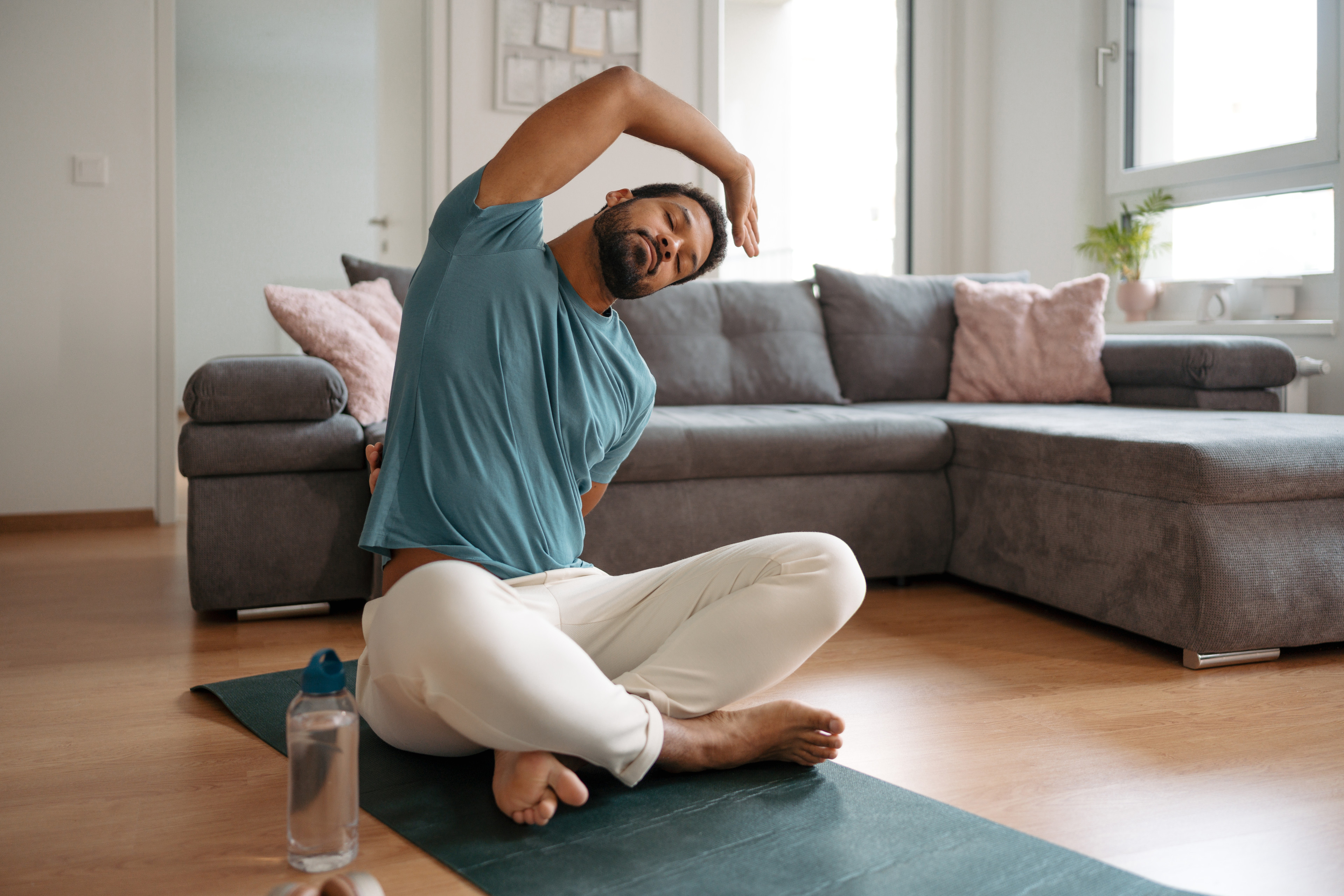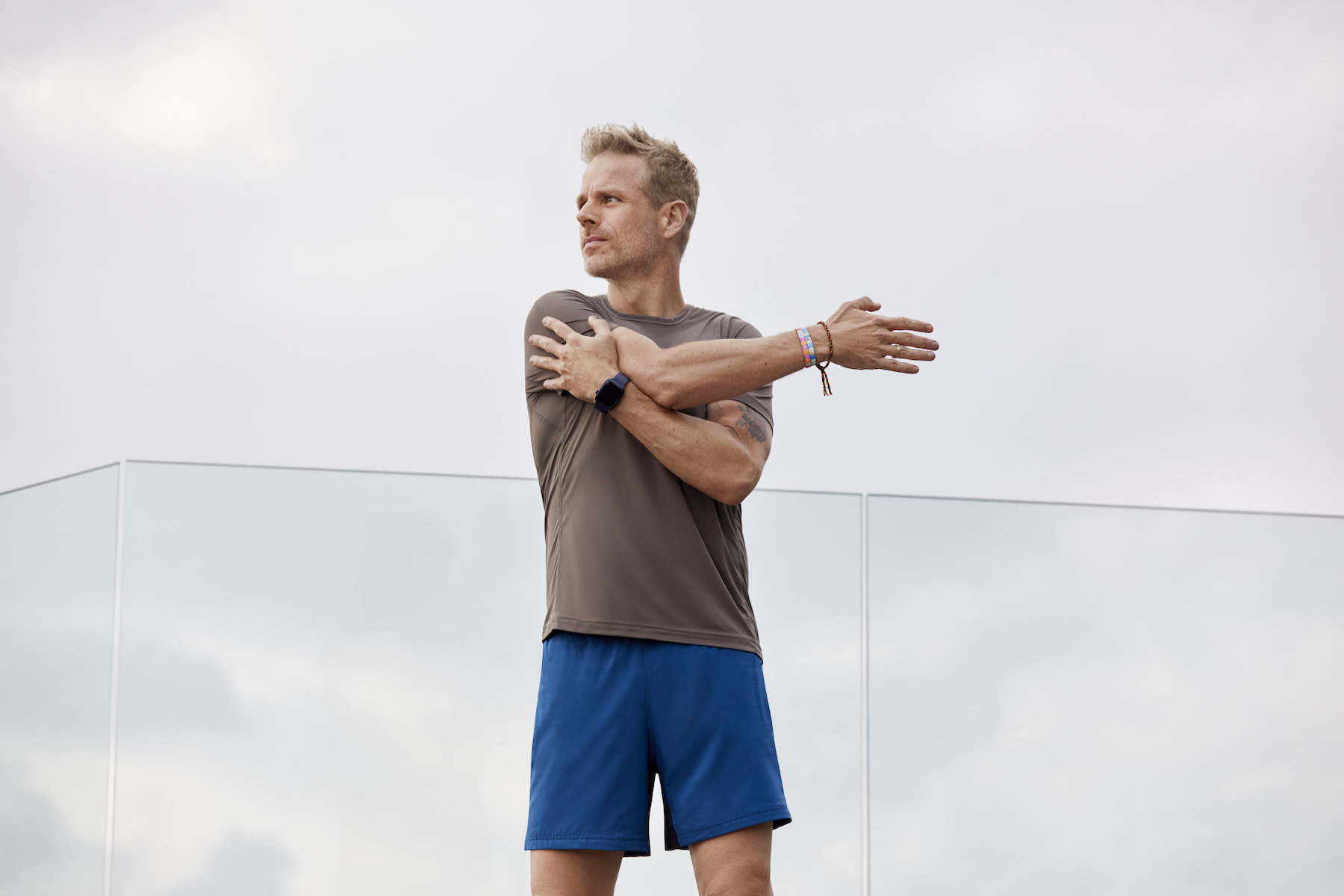
Halfpoint Images/Moment via Getty Images
A Beginner’s Guide to Stretching and Flexibility—Plus the 4 Best Stretches to Try
New to stretching? Here's where to start.
By Karen Asp•
The Benefits of Stretching for Beginners—and Beyond
How Do You Start Stretching?
The Different Types of Stretching, Explained
When Is the Best Time to Stretch?
4 Best Stretches for Beginners
Common Mistakes Beginners Make When Starting a Stretching Routine
Stretching Tools and Equipment for Beginners
Stretching isn’t exactly a headline grabber when it comes to working out. Health organizations such as the WHO recommend you do 150 minutes of cardio per week, and we know that strength training can make your muscles stronger(among other benefits). But stretching doesn’t always have the same appeal, hence the reason you might be tempted to skip it.
Yet not so fast. Stretching (even for beginners) is as important for your body as cardio and strength training, especially if you’re hoping to improve your performance in your workouts. Follow the guide below to learn all the ins and outs of stretching.
The Benefits of Stretching for Beginners—and Beyond
No doubt you’ve heard that stretching increases your flexibility, but why does that matter anyway? Turns out, it’s not just about your performance in your workouts but flexibility is important in daily life, too. “Lack of flexibility can lead to mobility limitations, which means your body is no longer able to move naturally,” says Peloton instructor Marcel Maurer. “Flexibility, along with agility, helps make movements in daily life better.”
Plus, if you want to keep your workouts going, you obviously want to avoid injury, which is yet another reason not to skimp on stretching. When you perform stretches that you hold, you’re lengthening your muscles. That’s especially crucial after a workout, as your muscles contract or shorten during movements. The problem? “If your muscles are shortened, your body can’t make movements correctly,” Marcel says. As a result, you’ll move incorrectly, forcing other muscles to correct that movement. Because those muscles aren’t used to working that way, they could become injured.
Stretching can also help alleviate muscular imbalances in the body. These imbalances have numerous causes, including sitting too much and being under chronic stress, Marcel says.
All of this explains why Marcel always spends 30 seconds stretching each muscle after a workout. “The focus is on reducing muscular imbalances, supporting correct movement execution and preventing injuries,” he says.
How Do You Start Stretching?
If you haven’t stretched much, it can be tough to know how to start. You might even be intimidated, especially if you think you’re not that flexible.
That’s why starting small is best. Slot in time for a five- or 10-minute stretch session a few times a week, Marcel says. As you get more comfortable with stretching and realize how good it makes you feel, you might then stretch for longer time periods. You should also stretch before and after your workout; see below for the type of stretching that’s best.
The Different Types of Stretching, Explained
Stretches tend to get lumped into one category. Yet there are two main types of stretches, each with their own benefits.
First is dynamic stretching where you’re moving your body to prepare for exercise. This type of stretching is best done before a workout. Common exercises include walking lunges, hip circles, arm circles, and leg pendulums.
The other type is called static stretching where you’re holding the stretch for roughly 30 seconds. For instance, you might do a standing quadriceps stretch or a hamstring stretch. With these stretches, you’re lengthening muscles that have contracted during your workout. That’s why it’s best to save static stretches for after your workout, Marcel says.
When Is the Best Time to Stretch?
This is a question everybody asks, but for the record, there is no bad time to stretch. You might, for instance, take stretch breaks throughout the day if you’ve been sitting too long and feel your muscles getting achy. Maybe you want to stretch before bed or even in the morning while you’re still in bed.
You can also plan to stretch before and after your workouts, but the type of stretching you do will vary for each, Marcel says. Before your workout, focus on dynamic flexibility exercises—think arm circles, side leg swings and bodyweight squats, according to the American College of Sports Medicine–while you should do static stretching after your workout.
4 Best Stretches for Beginners
Although you can take a live or on-demand Peloton Stretch Class, you can also do these four basic stretches from Marcel any time you want to unwind.
Just make sure you don’t feel pain while stretching. You’ll probably feel a little discomfort in particularly tight parts of your body. But stretching shouldn't hurt, so if you feel pain, pull back.

Standing Quadriceps and Hip Flexor Stretch
1. Stand with your feet hip-width apart and shift your weight into your left foot.
2. Keeping your knees next to each other, lift your right foot behind you.
3. Grab the top of your right foot with your right hand and place your left hand on a wall or chair if you need to balance.
4. With your right knee pointed toward the floor, pull that foot toward your butt until you feel a deep stretch in your right quad and hip flexor. Hold 30 seconds.
5. Release and repeat on the other side.
Hamstring Stretch
1. Stand with your feet hip-width apart, arms by your sides.
2. Fold forward from your hips (keep them stacked over your ankles) and reach your hands toward the floor.
3. Touch your knees, shins or ankles, whatever is possible for your flexibility.
4. You want to go as far as you can without bending your knees too much. Hold 30 seconds.

Cat Cow
1. Start on all fours, with your wrists below your shoulders, fingers forward, and knees under hips.
2. Inhaling, arch your back for Cow Pose.
3. As you exhale, round your back for Cat Pose.
4. Continue alternating for 30 seconds.

Shoulder Stretch
1. Stand with your feet hip-width apart.
2. Lift your right arm across your chest, hooking your left arm around it above your right elbow.
3. Use your left arm to draw the right arm toward your chest so you feel a stretch in your right shoulder. Hold 30 seconds.
4. Release and repeat on the other side.
Common Mistakes Beginners Make When Starting a Stretching Routine
It’s easy to make mistakes whenever you start a new activity, stretching included. Yet those mistakes could put you at risk of injury. Here are two to avoid when stretching:
Overstretching: Stretching can be uncomfortable at first. Yet if you push past that discomfort so that you wind up feeling pain, you’ve overstretched. That could put you at risk of injury. If you think of pain on a scale of one to 10 (10 being the most painful), you shouldn’t be higher than a six, Marcel says.
Doing static stretches before a workout: Static stretches will cause your muscles to relax, which is the opposite of what you’re trying to do in your warm-up. Instead, do them after your workout, Marcel says.
Stretching Tools and Equipment for Beginners
You don’t need any equipment to stretch. If, though, you want to get deeper into your muscles or want extra support, certain fitness tools can help. Consider resistance bands, a foam roller, yoga straps, yoga blocks, or even a towel, Marcel says.
This content is for informational and educational purposes only and does not constitute individualized advice. It is not intended to replace professional medical evaluation, diagnosis, or treatment. Seek the advice of your physician for questions you may have regarding your health or a medical condition. If you are having a medical emergency, call your physician or 911 immediately.
Level up your inbox.
Subscribe for a weekly dose of fitness, plus the latest promos, launches, and events.
By providing your email address, you agree to receive marketing communications from Peloton.
For more about how we use your information, see our Privacy Policy.





